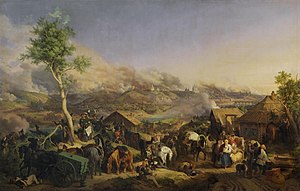Battle of Smolensk (1812)
| Battle of Smolensk | |||||||
|---|---|---|---|---|---|---|---|
| Part of the French invasion of Russia (1812) | |||||||
 Battle of Smolensk, by Peter von Hess |
|||||||
|
|||||||
| Belligerents | |||||||
|
|
|
||||||
| Commanders and leaders | |||||||
| Napoleon I of France |
Barclay de Tolly Pyotr Bagration |
||||||
| Strength | |||||||
| 200,000 men 50,000 engaged 84 artillery |
200,000 men 30,000 engaged 108 artillery |
||||||
| Casualties and losses | |||||||
| 4,200–10,000 killed and wounded | 4,000–14,000 killed, wounded and missing | ||||||
The Battle of Smolensk, the first major battle of the French invasion of Russia took place on August 16–18, 1812, between 175,000 men of the Grande Armée under Napoleon Bonaparte and 130,000 Russians under Barclay de Tolly, though only about 50,000 and 60,000 respectively were actually engaged. Napoleon attacked Smolensk occupied by Russian General Bagration's corps and captured two of the suburbs. During the night the Russians evacuated the burning city.
The Battle of Smolensk is commemorated on the Tomb of the Unknown Soldier, Warsaw, with the inscription "SMOLENSK 17 VIII 1812".
Initially the Russians employed hit and run tactics against the Grande Armée. Napoleon therefore devised the Smolensk Manoeuvre in an attempt to sweep behind the enemy and inflict a decisive defeat. On August 14, 1812 forces under the command of Joachim Murat, Marshal Davout, and Michel Ney crossed the Dnieper River at Rassna using bridges constructed overnight. The plan was to race toward the city, taking it without a fight, and march north to attack the rear of the main Russian forces under the overall command of General Barclay de Tolly. Unfortunately for the French, conflicting orders and a breakdown in communication had already led Bagration to disobey orders and instead of marching west, he occupied Smolensk to the south. By August 16, French forces found the city heavily garrisoned by Bagration's troops, further reinforced with the subsequent arrival of Barclay and the main Russian army.
Smolensk, a historic fortress city of 12,600 inhabitants on the main Western invasion route to Moscow was defended by bastion towers and a thick stone wall. The River Dnieper ran through the middle.
The Assumption Cathedral in Smolensk housed one of the most venerated icons of the Orthodox Church, Our Lady of Smolensk attributed to St Luke, and Napoleon assumed that the Russians would fight outside the city to avoid its destruction.
...
Wikipedia
